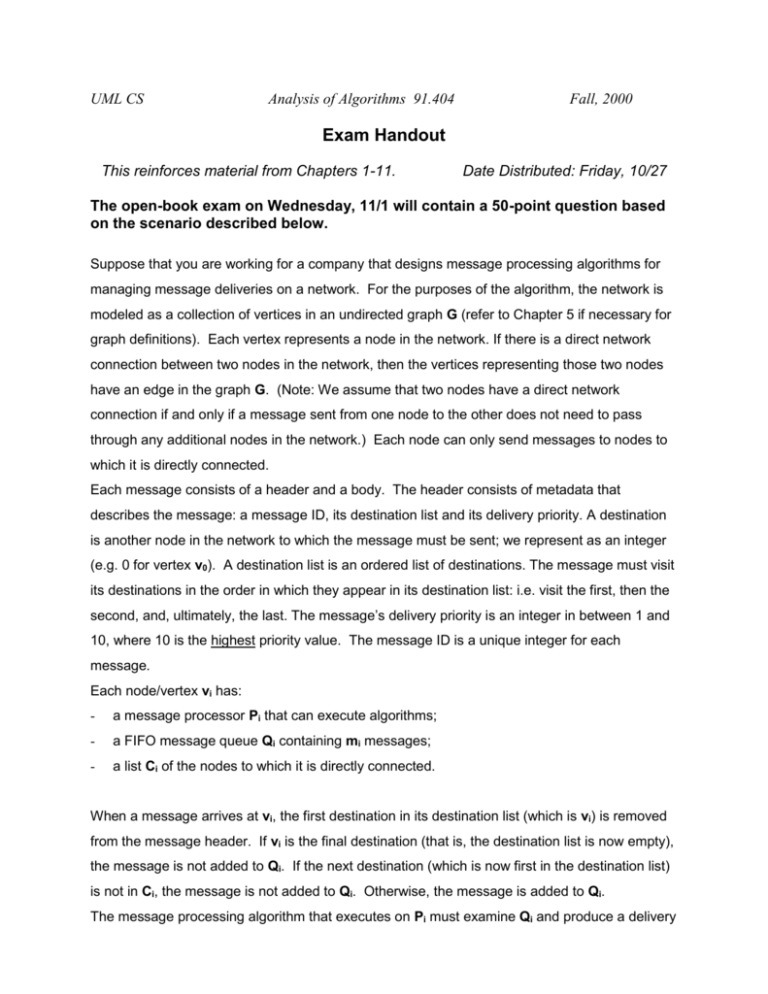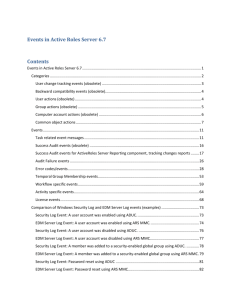Analysis of Algorithms, 91
advertisement

UML CS Analysis of Algorithms 91.404 Fall, 2000 Exam Handout This reinforces material from Chapters 1-11. Date Distributed: Friday, 10/27 The open-book exam on Wednesday, 11/1 will contain a 50-point question based on the scenario described below. Suppose that you are working for a company that designs message processing algorithms for managing message deliveries on a network. For the purposes of the algorithm, the network is modeled as a collection of vertices in an undirected graph G (refer to Chapter 5 if necessary for graph definitions). Each vertex represents a node in the network. If there is a direct network connection between two nodes in the network, then the vertices representing those two nodes have an edge in the graph G. (Note: We assume that two nodes have a direct network connection if and only if a message sent from one node to the other does not need to pass through any additional nodes in the network.) Each node can only send messages to nodes to which it is directly connected. Each message consists of a header and a body. The header consists of metadata that describes the message: a message ID, its destination list and its delivery priority. A destination is another node in the network to which the message must be sent; we represent as an integer (e.g. 0 for vertex v0). A destination list is an ordered list of destinations. The message must visit its destinations in the order in which they appear in its destination list: i.e. visit the first, then the second, and, ultimately, the last. The message’s delivery priority is an integer in between 1 and 10, where 10 is the highest priority value. The message ID is a unique integer for each message. Each node/vertex vi has: - a message processor Pi that can execute algorithms; - a FIFO message queue Qi containing mi messages; - a list Ci of the nodes to which it is directly connected. When a message arrives at vi, the first destination in its destination list (which is vi) is removed from the message header. If vi is the final destination (that is, the destination list is now empty), the message is not added to Qi. If the next destination (which is now first in the destination list) is not in Ci, the message is not added to Qi. Otherwise, the message is added to Qi. The message processing algorithm that executes on Pi must examine Qi and produce a delivery UML CS Analysis of Algorithms 91.404 Fall, 2000 schedule Si. The schedule Si lists the messages that vi will send. In Si, the messages appear in the order in which they will be sent. This order is determined based on the delivery priority and the order in which the messages appear in the message queue Qi. The order is consistent with the delivery priorities and the arrival order in Qi is used to break ties. v1 C1 Example: 2 C2 1 3 C3 v3 G v2 These will remain the same as algorithm(s) execute These will change as algorithm(s) execute. Here we show an example for one time period. v1 Q1 S1 v2 Q2 S2 messageID: 1 messageID: 2 destinationList: 2, 3 destinationList: 2 priority: 5 priority: 10 messageID: 2 messageID: 4 messageID: 5 messageID: 6 destinationList: 1 destinationList: 3 destinationList: 1 priority: 6 priority: 8 priority: 8 messageID: 5 messageID: 3 v3 Q3 destinationList: 2 priority: 1 S3 messageID: 1 messageID: 3 messageID: 6 messageID: 4 2








